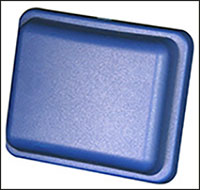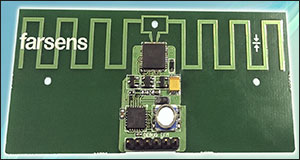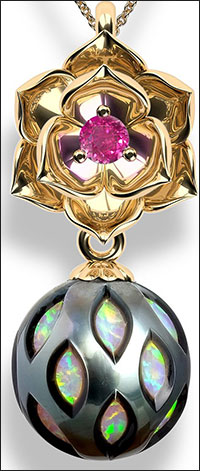The following are news announcements made during the past week by the following organizations:
HID Global;
Farsens;
BluVision, Proximity5;
Ubudu; the
OSPT Alliance; and
Galatea.
HID Global Intros New Keg Tag UHF for Kegs, Gas Bottles
HID Global has introduced a new on-metal RFID tag designed to fit into containers with a small radius, such as gas bottles. The new Keg Tag UHF transponder complements HID Global’s InLine Tag Ultra for beverage steel kegs, according to the company.
HID says it created the Keg Tag UHF transponder in response to requests from customers for a smaller, lighter on-metal tag that it is curved for exterior mounting on kegs and gas cylinders. The tag is readable from a distance of up to 19.6 feet (6 meters) with EPC Gen 2 devices. The tag’s durable housing (built to withstand rigorous washing and sterilization processes) is slightly curved along one axis for improved fit on round surfaces, according to HID Global, and can be mounted quickly and securely via quality industrial glues.
Made with an Impinj Monza 4E chip, which has 496 bits of Electronic Product Code (EPC) memory, 128 bits of user memory and a 96-bit tag identifier (TID), the new Keg Tag UHF measures 13 inches by 1.6 inches by 0.4 inch (33 millimeters by 40 millimeters by 9 millimeters) and has a 3-inch (74-millimeter) curve radius.
Farsens Announces Battery-Free RFID Pressure-Monitoring Tags
Farsens, a Spanish developer of RFID sensor tags, has announced three new battery-free RFID sensor tags designed for monitoring pressure. The company’s Cyclon tags can be used without batteries, allowing for a range of applications for which accessibility is restricted. As an example, they can be used with tire pressure monitoring systems in cars to monitor a tire’s inflation level. Because the Cyclon’s sensor is powered by the tag’s passive RFID transponder, there is no need for batteries—which add weight and can generate vibrations at high speeds, thus increasing risk of accidents—inside the tire.
The Cyclon-05BA is capable of transmitting a unique identifier and the associated absolute pressure measurement data to a commercial EPC Gen 2 reader. The device features an MS5803-05BA pressure and temperature sensor from Measurement Specialties to monitor pressures up to 6 bar, according to Farsens. The sensor can measure temperatures ranging from -40 degrees to +85 degrees Celsius (-40 degrees to +185 degrees Fahrenheit), and the reading distance for the battery-free pressure sensor tag is around 1.5 meters (5 feet). It can be embedded in a wide variety of materials, such as plastics or concrete. Evaluation kits are available.
Alternatively, the Cyclon-700A covers the same range as the Cyclon-05BA, with an analog sensor for a reduced accuracy and price. It includes an NPP-301A-700A pressure and temperature sensor from Amphenol Advanced Sensors, with an absolute pressure range from 0 bar to 7 bar and a temperature range of -40 degrees to +85 degrees Celsius.
The Cyclon-30BA includes an MS5803-30BA sensor from Measurement Specialties to cover ranges up to 30 bar and a temperature range of -40 degrees to 85 degrees Celsius.
All three designs are built in a PCB format, Farsens reports, and are available in a variety of antenna designs and sizes, depending on the specific application. They can be encapsulated in an IP67 or IP68 casing for usage in harsh environments.
Bluvision Buys Proximity5 to Strengthen Beacon Campaign Management Capabilities
Bluvision has announced that it has acquired Delaware-based Proximity5, a provider of a platform for managing Bluetooth-enabled marketing campaigns. The acquisition expands BluVision’s existing beacon-management suite, adding a comprehensive administration and campaign management system (CMS) for controlling beacons, as well as creating reports and analytics.
The combination of Bluvision with Proximty5 will offer customers a comprehensive Bluetooth management system, according to Bluvision, which retailers, advertising agencies and marketers need to deploy and manage beacon proximity campaigns, by providing them with a single, simple CMS dashboard system with which to manage beacons and marketing campaigns.
The management system will let customers build micro-location-enabled apps around BluVision’s BEEK beacons in its BluZone cloud platform, which is designed to help businesses improve beacon performance, discovery, integration and management, in order to simplify beacon mobile deployments and efficiency from a single portal. According to Bluvision, the new Proximity5 CMS integration enabled by the acquisition will add a more robust user experience for new and existing mobile apps to share beacon proximity locations with third-party apps or marketing systems.
In September 2014, BluVision announced its plan to provide enterprises worldwide with a full Bluetooth beacon cloud-based control solution and ecosystem, including the company’s BEEKS line of Bluetooth Low Energy (BLE) beacons and BluFi Bluetooth-to-Wi-Fi gateway.
BluVision’s BEEKS beacons are available with up to eight built-in sensors for real-time detection of such things as ambient light, motion, sound, temperature, humidity and height. With BluFi, enterprises can use existing mobile and software systems to set up, manage and receive alerts and data from up to 1 million beacons. The AC-powered plug-and-play gateway is designed to allow users to run reporting data remotely from any brand beacon at low-cost via cloud connectivity. BluFi is currently being deployed at Miami International Airport to monitor environmental conditions (for example, air conditioning temperature) and other passenger convenience services, including indoor navigation and travel alerts (see Major Beacon Deployment Takes Off at Miami International Airport).
Ubudu Unveils Beacon Platform With Two-Way Communication
Ubudu, a provider of mobile proximity solutions, has unveiled uBeacon Mesh, a platform enabling Bluetooth Low Energy (BLE) beacon installations to be used to create two-way communication with consumers.
With basic beacons complying with the Bluetooth 4.0 standard, a smartphone can detect a person’s proximity to a beacon and trigger an action, ubudu explains, but that action (such as offering a promotional discount or detecting that person’s entrance into a store) hits a dead end if an Internet connection is unavailable due to a lack of Wi-Fi, or if the smartphone cannot use cellular service (which happens often at indoor malls, stores and stadiums). In contrast, ubudu’s uBeacon Mesh beacons leverage the Bluetooth 4.1 standard, enabling them to use a two-way communication protocol. The uBeacon Mesh beacon can pass on information from the phone via a mesh network of other uBeacon Mesh beacons, using Bluetooth technology (rather than Wi-Fi or 4G), so the smartphone and beacon can communicate to trigger an action.
The uBeacon Mesh beacon is made with a Bluetooth 4.1 chip manufactured by CSR and firmware from ubudu. The company says it plans to release the uBeacon Mesh platform, which includes a software developer’s kit (SDK) for creating apps or updating existing ones to work with uBeacon Mesh beacons, in early 2015. The company will offer several different plans, which vary depending on a customer’s needs. For example, there is a free developer’s plan that supports only 1,000 active users (consumers) monthly, offers no security features, and is designed for testing, or a pro plan which supports 25,000 active users monthly and includes premium support (phone and e-mail), as well as maintenance, developer studio modules and database replication.
OSPT Alliance Expands Presence in North America
The Open Standard for Public Transport (OSPT) Alliance has announced the launch of a North American Sub-Working Group (Sub-WG), consisting of both members and associate members who have an interest in North American public transport and are experts in this field. The OSPT Alliance is focused on open standards for secure transit fare-collection solutions, which it says promotes vendor neutrality and cross-vendor system interoperability, while also providing transit operators with greater flexibility in implementing new applications than proprietary, single-vendor technologies.
The new group’s core activity, according to the OSTP, will center on engaging with stakeholders operating across the North American transport ecosystem to understand current and future ticketing requirements. This will contribute to and communicate the advancement of CIPURSE, the OSPT Alliance’s open-standard RF-agnostic platform for securing multiple payment types. Built on specifications that include ISO 14443-4 for passive high-frequency (HF) RFID tags, CIPURSE establishes a common set of commands to be used between a card and a reader, as well as a standard card data structure. It is form-factor-independent, and is designed for use in smart cards, Near Field Communication (NFC) mobile phones and other devices. The new group will also work to highlight the benefits of integrating CIPURSE into existing ticketing infrastructures in order to deliver cost efficiencies and support multiple, non-transport applications as part of a public/private partnership.
“We recognize that North America is a key market for the alliance and wanted to demonstrate our commitment by establishing this working group,” said Laurent Cremer, the OSPT Alliance’s executive director, in a prepared statement. “The alliance understands that each transport community faces different challenges and opportunities and it is vital that we understand and respond to advance the ecosystem. This will only be achieved by having North American representatives contributing to our work.”
The Sub-WG will be chaired by Arnaud Moser, Infineon Technologies‘ director of marketing and business development, chip cards and security.
Galatea Markets NFC-tagged Cultured Pearls
Jewelry maker Galatea has unveiled a cultured pearl with an embedded Near Field Communication (NFC) RFID tag that lets users create a tailored voice message that can be played by tapping the pearl against an NFC-enabled smartphone. Galatea’s Momento Pearl can use NFC RFID to deliver other types of digital content as well, including images, messages and videos.
According to Chi Huynh, Galatea’s founder and the inventor of Momento Pearl, the tag inside the pearl is customized in-house (Galatea buys the chip and antenna and then creates its own NFC tag), and the procedure for inserting the tag into the pearl is patent-pending. The cultured pearl does not interfere with the NFC functionality, Huynh reports.
Once the Galatea app has been downloaded onto an NFC-enabled phone or tablet, the user can record a message or upload an audio file. Tapping the pearl against an NFC-enabled mobile device causes the audio file to be played and digital material to be displayed.
Known for its hand-carved cultured Tahitian and freshwater pearls (the Momento Pearl collection features only hand-carved pearls), Galatea also owns a number of patents for its pearl and gemstone jewelry. In 2005, the company introduced the Galatea Pearl, which is cultured using a colored stone bead. After the pearl’s nacre is carved away, the color can be seen below its surface.
The firm is now taking orders for the NFC-enabled pearls, for delivery to stores by Jan. 20, 2015. The Momento Pearls will be available at 1,400 retailer locations; customers can call 800-609-6888 (in the United States only) or 909-592-0877 to find a nearby dealer. According to Huyhn, Galatea plans to introduce additional NFC-enabled jewelry, including gemstones and diamonds, during the coming months.
Another company has embedded RFID tags in cultured pearls so they can be identified and tracked. In 2013, Fukui Shell Nucleus Factory, a Hong Kong provider of equipment and services to the pearl industry, released a solution consisting of a tiny RFID tag embedded in a pearl’s nucleus that could transmit an ID number to an RFID reader (see Pearl Company Creates Authentication Solution).




